A locally driven push to restore a Himalayan paradise preserved an economy, a community and an ecosystem all at once.
By Geetanjali Krishna
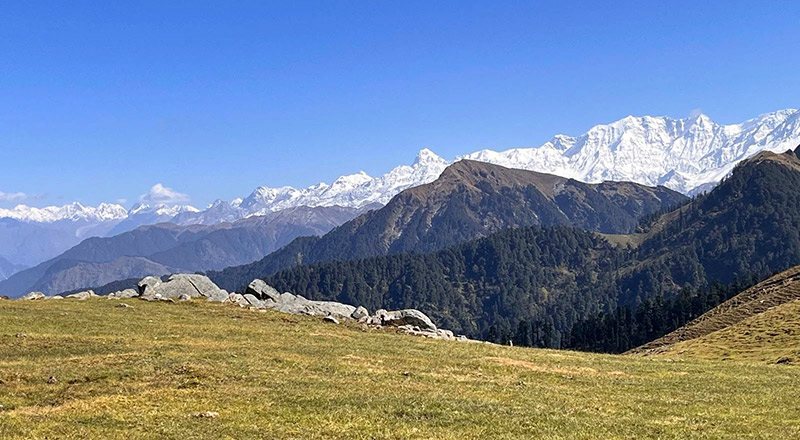
It’s a bright autumn morning in 2022. We’ve hiked up a steep Himalayan mountainside, heavily wooded with oak and rhododendron, to a sprawling meadow on the old bridle route of the Hindu pilgrimage sites Gangotri and Kedarnath. At 3,800 meters (12,467 feet), it feels like the top of the world, with grasses and wildflowers as far as the eye can see, and the snow-capped Himalayan peaks of Kalanag, Bandarpunch, and Swargarohini beyond.
Dark clouds gather overhead; there is no shelter for miles. “The weather has become increasingly erratic here,”, says our trek guide Nawang. “It rarely rains in October, but this year we have seen unprecedented wet weather, which has caused these gullies to fill and deepen.”
We make haste to our campsite, passing several gullies with frozen water. Soon after we reach the warmth of our camp, it begins to snow, at least a month too early for this elevation. This is the last day of our trek.
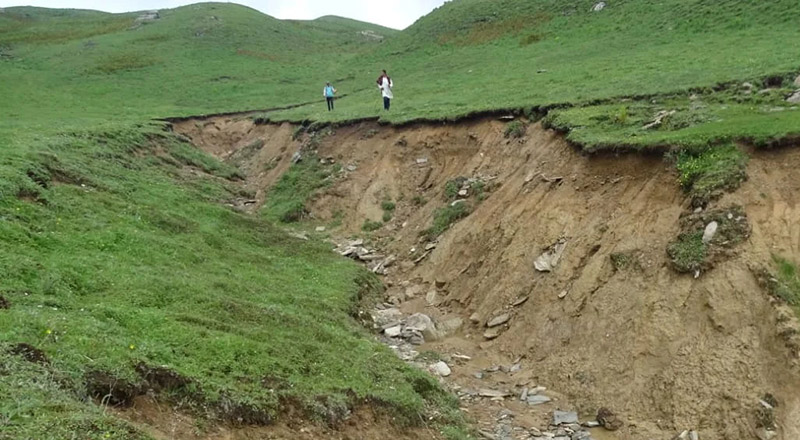
Endeavors to shield nature from such assaults can bring their problems, from economically painful tourism bans to brute-force concrete berms that do harm themselves. What if Uttarakhand officials could find a way to protect the environment, the economy, and the local communities all at once?
“When I first set eyes on this spectacular meadow, I was struck by the different human stressors as well as natural climatic factors endangering it,” says Sandeep Kumar, the divisional forest officer of the area between 2018 and 2021. “Nomadic shepherds traditionally camped there with their livestock, unattended cattle of the adjacent villages grazed there, and it had become one of Uttarakhand’s most popular trekking destinations because of its beautiful expanse of grassy meadows and easy accessibility.”
Over the last five years, however, the number of tourists visiting the local meadow of Dayara Bugyal has increased by 186 percent, to about 2,850 visitors per year.
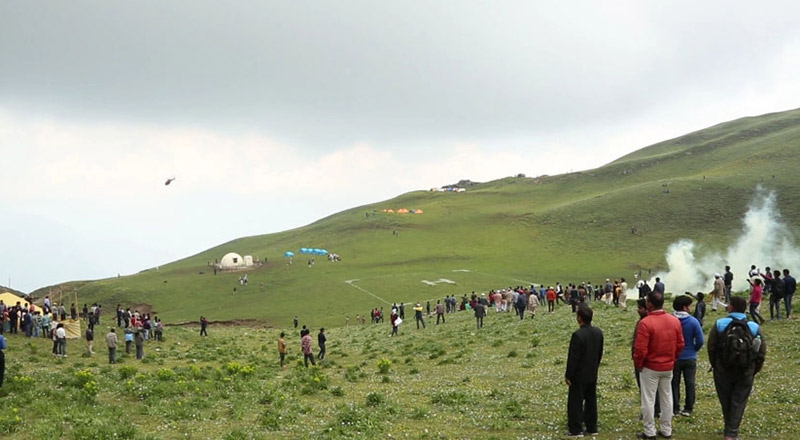
Kumar also found that overgrazing resulted in denudation and trampling of the grasses. Gullies formed by erosion widened and deepened in every monsoon. This funneled the rainwater, silt, and debris downhill at great speed, increasing the risk of flash floods, landslides, and rockfalls in the heavily populated lower elevations.
“The government and forest department wanted us to come up with a solution after the state High Court acknowledged the urgent need to restore meadows in Uttarakhand,” Kumar recalls. “Given how ecologically fragile they were, building concrete check dams would have been folly. Imagine the cost of ferrying the heavy materials up, and the environmental havoc all that cement would wreak on these meadows.”
Bioengineering presented a viable solution.
Kumar and his team at the Uttarkashi forest division began training women from the village of Raithal to stitch coir, a biodegradable fiber obtained from the husk of coconuts, into logs. The logs were then filled with waste pine needles, locally called pirul. “In an area of 6,600 square meters, we filled every gully with these logs and tethered them with bamboo pegs,” Kumar says. They also constructed check dams using the same logs to further reduce the speed of water and collect the topsoil being carried away by rainwater.
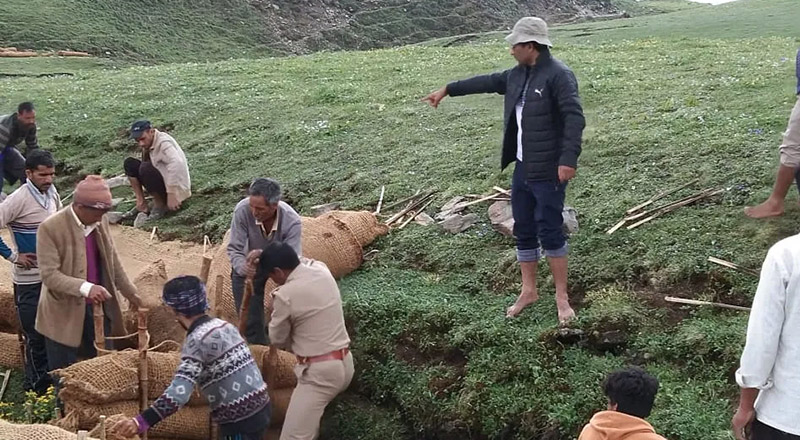
When Kumar and his team visited the restoration sites during the flowering season, they observed that the coir matting and trapped silt had optimized the temperature and soil conditions for germination. “We found that not only had the seeds we’d sown taken root, but many other species had also germinated because their seeds were in the topsoil trapped in the logs,” he says.
“I remember a particularly intense spell of rain barely months after we built these check dams,” Kumar says. “I trekked up to Dayara worried that much of our hard work had been destroyed.” Instead, the bioengineered check dams were intact and had in fact slowed down the flow of water from the meadow to the waterfalls and streams below. He reckons it will take between three and four years for the coir and pine needles to decompose into mulch. By then, the gradual buildup of silt and organic material will allow these restored patches to blend seamlessly with the natural meadows.
Repairing the damage was only half the battle, however. Kumar and the forest department had to simultaneously figure out how to regulate the human and cattle activity that had contributed to the denudation of Dayara Bugyal in the first place.
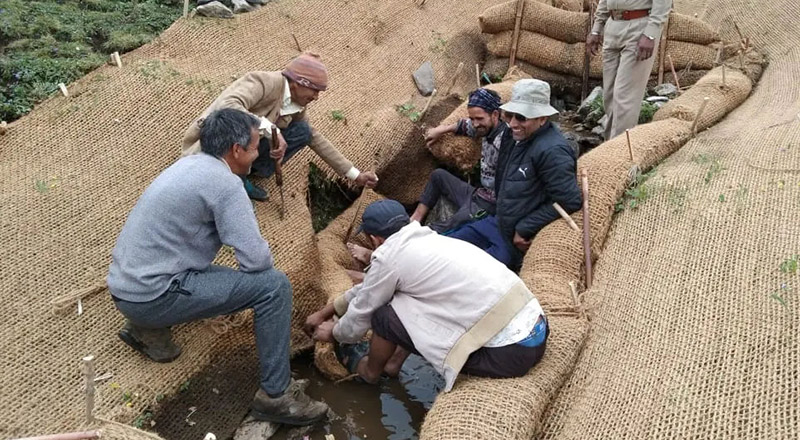
“Initially when the residents of Raithal village heard about the plan to restore Dayara Bugyal, we worried about access to our grazing grounds,” Rawat says. “Our animals needed to eat, too!”
Regular meetings in 2018 explained that the restoration of Dayara planned to divert and reduce, and not take away, their grazing rights. “We also realized that this would provide us employment, rare to find in villages like ours,” Rawat says.
The villagers created a group of about 70 members who stitched coir logs and filled them with pine needles. Local mule owners carried the logs, bamboo, and other material up to the meadow, where other group members built the check dams and filled the gullies. Mohan Lal, a marginal farmer (meaning, owning up to one hectare) and orchard owner, was one of them. “In the two months it took for the project to be implemented, each member earned between USD 300 and 370” he says. “That’s very good money for a village with few livelihood opportunities.”

Additionally, the forest department developed an alternate grazing ground to reduce the pressure on Dayara. Kuniyal assesses that this, along with the regular meetings to sensitize local communities, has reduced the number of animals who graze there. “The use of locally made coir logs filled with locally available organic materials has helped reduce the project cost by at least 20 percent and also generated direct and alternate livelihood opportunities for 700 households,” he says. “I feel that perhaps the project cost could further be reduced if one is able to find a locally available material to replace the coir, which comes from at least 1,500 miles away.”
Environmentalists have used several techniques to restore alpine and subalpine meadows the world over, including using snowmelt to recharge groundwater in California’s Yosemite National Park and regulating grazing practices in Western Himalayan alpine paddocks and China. However, the Dayara Bugyal project stands out for its replicability: it is low cost, involves the community and the logs can be made with locally available fibers and biomass. “It took two months and cost about Rs 27 lakh (approximately USD 33,110) to execute this project,” Kumar says. “And by enlisting local community help, we ensured its continuity without compromising their socio-economic needs.”

The Dayara Bugyal model has been recognized by the Uttarakhand government as one of the most suitable ways to restore Himalayan meadows with significant gully erosion. It is in the process of being replicated across the state and in other parts of the country, too. The technique can also be used to bioengineer repairs in the Himalayas and other ecologically fragile landscapes. “For example, it can be used to support terraces on mountain slopes, on which subsistence farmers grow their crops. It can also be used to anchor fragile slopes that have become prone to landslides and rock falls,” Kumar says.
Meanwhile, Rajbir Rawat is optimistic that Dayara Bugyal could soon return to its former, magical glory. “Raithal would benefit from the increase in tourist arrivals,” he says, “and I might just see the flowers and herbs of my childhood once again.”
This story was originally published on Reasons to be Cheerful and is republished within the Human Journalism Network program, supported by the ICFJ, International Center for Journalists.
Over the last two decades, Geetanjali Krishna has traveled across India to report on the environment, climate change and global health. She co-founded The India Story Agency, a cross-border media collaborative with London-based journalist Sally Howard in 2020.
